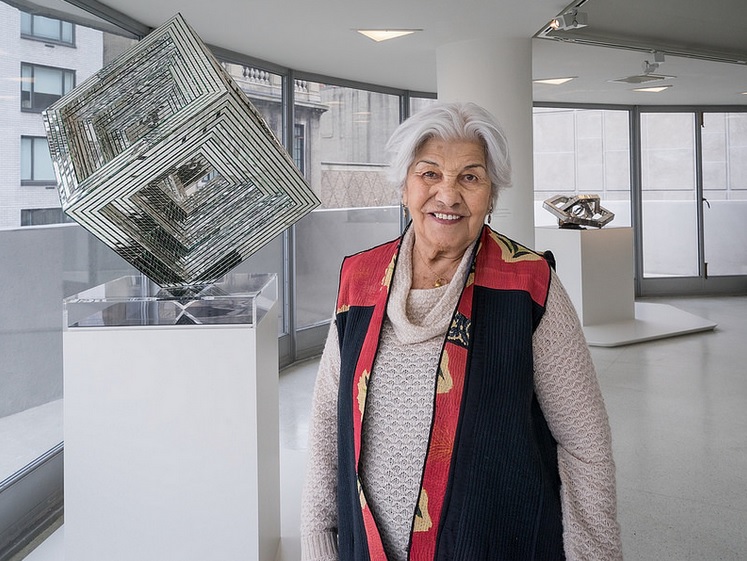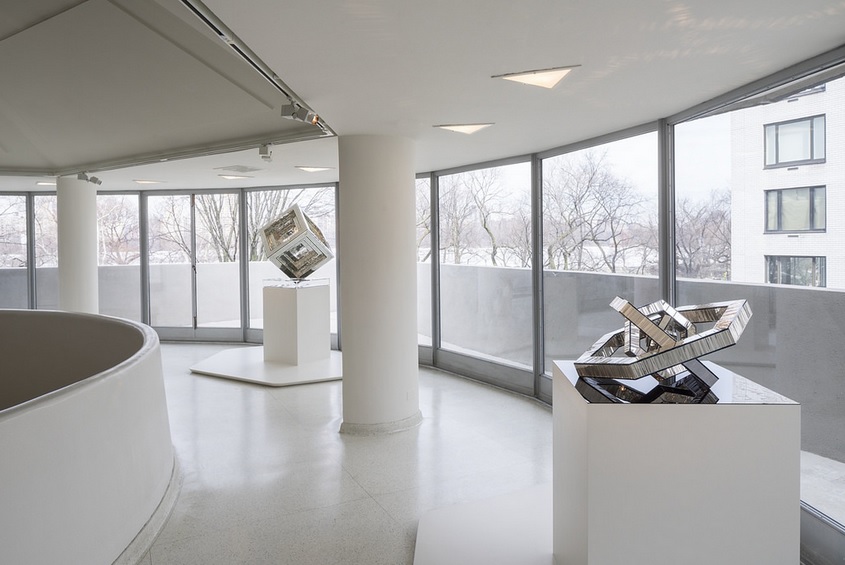
By Sana Panjwani
Born in Qazvin, Iran in 1924, Monir Sharoudy Farmanfarmaian is a renowned visual artist known for her unique geometric artistry and mirror sculptures.
Having studied art at the Fine Arts College at the University of Tehran in Iran and then in the United States at Cornell University and Parson’s School of Design, Farhmanfarmaian has spent over six decades pursuing her passion and remarkable talent that has led her to become the first Iranian artist to have a solo exhibition at the Guggenheim Museum in New York.
Her show, titled Infinite Possibility: Mirror Works and Drawings 1974 – 2014, is more than just an exhibition of her work in a world-famous museum. It signifies hope – for women, for artists and for bridging the gap between the Middle East and the West.
Farmanfarmaian’s works are rightfully described as “visually gorgeous and thought-provoking,” drawing on ancient Sufi geometric aesthetics, and decorative traditions from the Safavid and Qajar era.
“Although she uses very old techniques, she is always oriented with her vision of the future,” said Hans Ulrich, the co-director of London’s Serpentine Gallery – a trait that shines through her interpretations of Minimalism and Abstract Expressionism.
Farmanfarmaian’s most compelling works including a combination of mirror mosaics (traditional Islamic designs which have been used to decorate the inside of Iranian shrines and palace since the 16th century) and reverse glass paintings – where images are carefully painted onto sheets of glass that are then viewed from the other side.
“Around 1971, I went to a certain shrine [in Iran],” Monir told the Guardian. “I became very awed with the way the mirror pieces were reflecting back images of the people there – the beggars, the holy men. It was so beautiful, so magnificent. I was crying like a baby.”

Besides being an artistic inspiration to many, Farmanfarmaian’s delicate blend of Eastern and Western techniques and achievements also hinge on cultural diplomacy.
Shiva Balaghi, a scholar in Middle Eastern Studies, says that that the fact that Farmanfarmaian has been granted the opportunity of a solo exhibition at the Guggeinheim is representative of the notion that art institutions are beginning to look beyond Iran’s politics and experience the country through its art instead. “It’s almost like museums are taking on this cultural diplomacy role,” she told Buzzfeed News. “There’s a cultural life in that country that continues and flourishes, one that doesn’t have to do with nuclear negotiations.”
The Guggenheim chose to examine Monir’s work through a “transnational perspective on artistic production” and commented: “This body of work is characterized by a merging of visual and spatial experience, coupled with the aesthetic traditions of Islamic architecture and decoration. Her use of geometry as form allows for, in the artist’s words, ‘infinite possibility.’
During her time in New York, Farmanfarmaian also met a number of world-famous artists from Andy Warhol and Joan Mitchell to Milton Avery and Willem de Kooning, all of whom, in one way or another, inspired her artistic style and technique. She further developed her artistic sensibilities through encounters with traditional craftsmanship, “indigenous art forms such as Turkoman jewellery and clothing, coffee house paintings, narrative paintings and the technique of reverse-glass painting.”
Since 2004, Farmanfarmaian has been settled in Iran, re-establishing her former studio there and working with several trusted craftsmen.

Her solo exhibition is also a symbol of reconciliation between Middle East and West.
“In America, after the revolution, after the [Gulf] war, nobody wanted to do anything with Iran,” Farmanfarmaian told the Guardian. “None of the galleries wanted to talk to me. And after September 11 – my God. No way. Rather than being a woman, it was difficult just being Iranian.”
Monir is not the only Iranian artist to have a solo exhibition at this time though. Parviz Tanavoli, the famed Iranian sculptor, will also be displaying his work at the Davis Museum at Wellesley College. This is, says Shiva Balaghi, not a re-emergence of Iranian art in US. “The fact that there’s a growing interest in the West is key, not that this art hasn’t been made before.”
According to Balaghi, one section of the exhibit features one of Farmanfarmaian’s mirror sculptures near a window that overlooks Central Park, that “symbolizes for her the relationship of American modernism and Iranian contemporary art.”
Spanning four decades of work, Farmanfarmaian’s remarkable, pioneering exhibition, while occurring late in her career, will certainly not be her last.
“Whatever time I have left, I want to make art,” said Farmanfarmaian. “And I hope it will be worthwhile to see it.”



















[…] “they’re just like us”, but the passion and determination of local skaters. Or take the story of Monir Sharoudy Farmanfarmaian, the first Iranian artist to have a solo exhibition at the […]
[…] “they’re just like us”, but the passion and determination of local skaters. Or take the story of Monir Sharoudy Farmanfarmaian, the first Iranian artist to have a solo exhibition at the […]